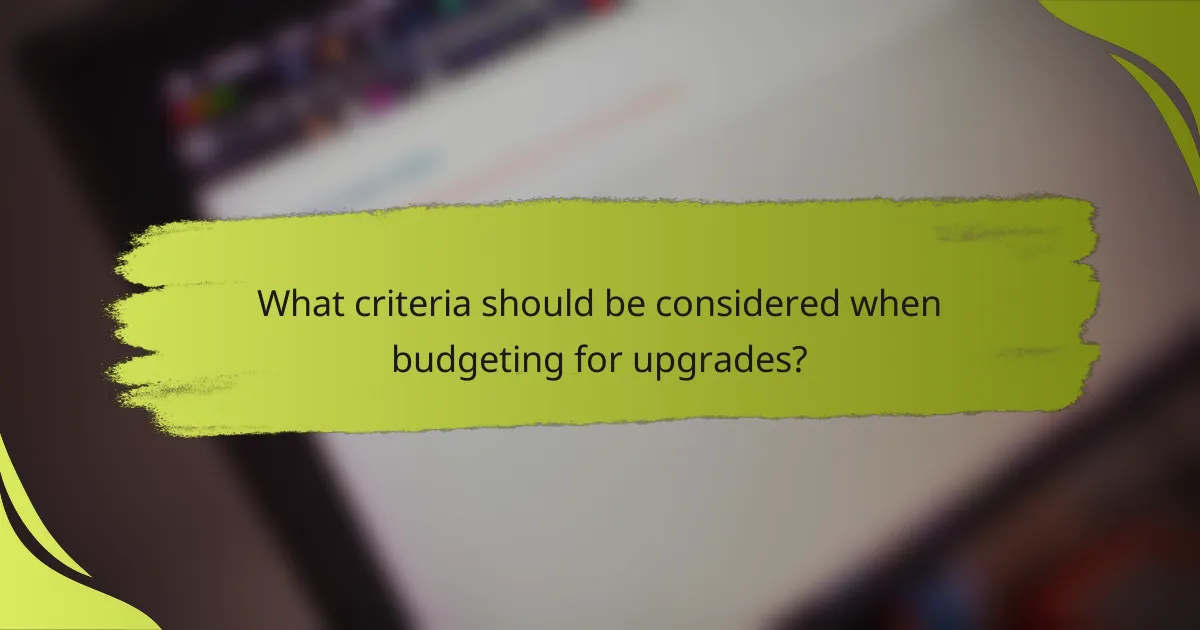Budgeting for upgrades is essential for homeowners looking to enhance their property while managing costs effectively. By understanding the various expenses involved, including initial investments and ongoing maintenance, you can make informed decisions about the timing and scope of your upgrades. Planning ahead allows you to align your financial readiness with market conditions, maximizing the benefits of your improvements.

What are the costs of budgeting for upgrades?
Budgeting for upgrades involves several costs, including initial investments, ongoing maintenance, and potential unexpected expenses. Understanding these costs helps in making informed decisions about when and how to upgrade effectively.
Initial investment estimates
The initial investment for upgrades can vary significantly based on the type of upgrade and the scale of the project. For instance, upgrading software might cost a few hundred to several thousand dollars, while hardware upgrades could range from a few hundred to tens of thousands of dollars depending on the specifications.
It’s crucial to gather multiple estimates from vendors and consider not just the purchase price but also installation and training costs. This comprehensive view will help in setting a realistic budget.
Ongoing maintenance expenses
Ongoing maintenance expenses are often overlooked but are essential for budgeting. These costs can include software subscriptions, hardware servicing, and regular updates, which may range from a few percent to over ten percent of the initial investment annually.
Consider establishing a maintenance fund to cover these recurring costs, ensuring that your upgrades remain functional and up-to-date without straining your budget later on.
Unexpected costs
Unexpected costs can arise during upgrades due to unforeseen issues like compatibility problems or additional training needs. It’s wise to allocate an additional 10-20% of your total budget to cover these potential surprises.
Conducting thorough research and planning can help minimize these risks, but having a contingency fund is a practical strategy to avoid financial strain during the upgrade process.
Financing options
Financing options for upgrades can include loans, leasing, or using credit lines. Each option has its pros and cons; for example, leasing may lower upfront costs but could result in higher long-term expenses.
Explore various financing solutions and choose one that aligns with your cash flow and financial goals. Consulting with a financial advisor can provide insights tailored to your specific situation.
Cost-benefit analysis
A cost-benefit analysis helps determine whether the benefits of an upgrade justify the expenses involved. This analysis should consider both tangible benefits, like increased efficiency, and intangible benefits, such as improved employee satisfaction.
To perform a cost-benefit analysis, list all expected costs and benefits, assign values where possible, and calculate the return on investment (ROI). A positive ROI indicates that the upgrade is likely worth the investment.

What are the benefits of budgeting for upgrades?
Budgeting for upgrades allows homeowners to strategically enhance their property while managing costs effectively. By planning ahead, you can maximize the benefits of improvements, ensuring they align with your financial goals and property needs.
Increased property value
One of the primary benefits of budgeting for upgrades is the potential increase in property value. Well-planned renovations can yield returns that significantly exceed the initial investment, often in the range of 70-90% for kitchen and bathroom remodels.
Consider focusing on upgrades that are in demand in your local market, such as adding a deck or improving curb appeal. These enhancements not only attract buyers but can also lead to quicker sales.
Improved energy efficiency
Upgrading to energy-efficient appliances and systems can lead to substantial savings on utility bills. Budgeting for these upgrades allows you to invest in technologies that reduce energy consumption, such as LED lighting, smart thermostats, and high-efficiency HVAC systems.
In many regions, homeowners can also benefit from tax credits or rebates for energy-efficient upgrades, which can further offset costs. Research local programs to maximize your savings.
Enhanced functionality
Budgeting for upgrades can significantly enhance the functionality of your home. This might include reconfiguring spaces for better flow or adding features like built-in storage solutions that make daily living more convenient.
When planning, consider your lifestyle needs. For example, if you work from home, investing in a dedicated office space can improve productivity and comfort.
Better aesthetic appeal
Upgrades can greatly improve the aesthetic appeal of your home, making it more inviting and enjoyable. Budgeting for cosmetic changes, such as new paint, flooring, or landscaping, can transform your space without requiring a large financial outlay.
Focus on trends that resonate with your personal style while also appealing to potential buyers. Simple updates like modern fixtures or fresh landscaping can create a significant impact at a relatively low cost.

When is the best time to budget for upgrades?
The best time to budget for upgrades is when you can align your financial readiness with market conditions and seasonal trends. This ensures that you maximize the benefits while minimizing costs.
Seasonal considerations
Seasonality can significantly impact the costs of upgrades. For instance, many home improvement projects are cheaper during the off-peak seasons, such as late fall or winter, when contractors are less busy and materials may be discounted.
Additionally, consider the timing of your upgrades in relation to seasonal weather. For example, exterior renovations are best planned for spring or early summer to avoid delays caused by adverse weather conditions.
Market trends
Staying informed about market trends is crucial for budgeting upgrades effectively. Prices for materials and labor can fluctuate based on demand, so monitoring these trends can help you choose the right time to invest.
For example, if you notice a rise in demand for energy-efficient appliances, it may be wise to budget for these upgrades before prices increase further. Conversely, waiting for a downturn in demand can lead to better deals.
Personal financial readiness
Your personal financial situation plays a vital role in determining when to budget for upgrades. Assess your savings, income stability, and existing financial obligations to ensure you can comfortably afford the costs without compromising your financial health.
Establish a budget that includes not only the direct costs of the upgrades but also potential unexpected expenses. A good rule of thumb is to set aside an additional 10-20% of your budget for contingencies.
Timing for maximum ROI
To achieve the best return on investment (ROI) from your upgrades, timing is essential. Upgrades that enhance energy efficiency or curb appeal tend to yield higher returns when completed before peak selling seasons, such as spring for real estate.
Consider conducting upgrades that align with local market demands. For instance, in urban areas, modern kitchen and bathroom renovations often attract buyers, making them a smart investment when timed with market peaks.

How to create a budgeting plan for upgrades?
Creating a budgeting plan for upgrades involves assessing your needs, setting financial limits, and exploring funding options. A well-structured plan helps you prioritize upgrades while ensuring you stay within your financial means.
Identify upgrade priorities
Start by determining which upgrades will provide the most value or impact. Consider factors such as functionality, energy efficiency, and aesthetics. For example, upgrading to energy-efficient appliances may yield long-term savings on utility bills.
List potential upgrades in order of importance, focusing on those that address immediate needs or significantly enhance your living or working environment. This prioritization will guide your budgeting decisions.
Set a realistic budget
A realistic budget should reflect both your financial capacity and the costs associated with each upgrade. Research average costs for similar upgrades in your area to establish a baseline. For instance, kitchen remodels can range from a few thousand to tens of thousands of dollars depending on scope.
Include a buffer in your budget for unexpected expenses, typically around 10-20%. This cushion will help you manage any surprises without derailing your overall financial plan.
Research financing options
Explore various financing options to fund your upgrades, such as personal loans, home equity lines of credit, or government grants. Each option has its pros and cons, including interest rates, repayment terms, and eligibility criteria.
Consider low-interest credit cards for smaller projects or financing through contractors for larger upgrades. Always compare offers to find the best terms that suit your financial situation.
Track expenses
Tracking expenses is crucial to ensure you remain within your budget. Use budgeting apps or spreadsheets to monitor spending on upgrades, categorizing expenses to identify areas where you may overspend.
Regularly review your budget against actual expenses and adjust as necessary. This practice not only keeps you accountable but also helps you make informed decisions for future upgrades.

What criteria should be considered when budgeting for upgrades?
When budgeting for upgrades, consider the overall costs, potential benefits, and the timing of the investment. Key factors include the current condition of your assets, the expected return on investment (ROI), and the urgency of the upgrades needed.
Cost of Upgrades
The cost of upgrades can vary widely based on the type of improvement and the scale of the project. For instance, software upgrades may range from a few hundred to several thousand dollars, while hardware upgrades can cost from low hundreds to tens of thousands, depending on the specifications. It’s essential to obtain multiple quotes and consider both direct costs and potential hidden expenses.
In addition to initial costs, factor in ongoing maintenance and operational costs. For example, upgrading to energy-efficient systems may have a higher upfront cost but can lead to significant savings on utility bills over time.
Benefits of Upgrades
Upgrades can provide numerous benefits, including improved efficiency, enhanced performance, and increased safety. For instance, upgrading to modern software can streamline operations and reduce downtime, while hardware upgrades can boost processing speed and capacity.
Consider the long-term benefits as well. An upgrade that enhances productivity can lead to higher revenue, while improvements in safety can reduce liability and insurance costs. Evaluate how these benefits align with your overall business goals.
Timing of Upgrades
Timing is crucial when budgeting for upgrades. Assess whether the current market conditions favor immediate investment or if it’s better to wait for more favorable pricing or technological advancements. Seasonal trends can also impact costs; for example, purchasing equipment during off-peak seasons may yield better deals.
Additionally, consider the lifecycle of your current assets. If equipment is nearing the end of its useful life, it may be more cost-effective to upgrade sooner rather than later to avoid increased repair costs and downtime.
